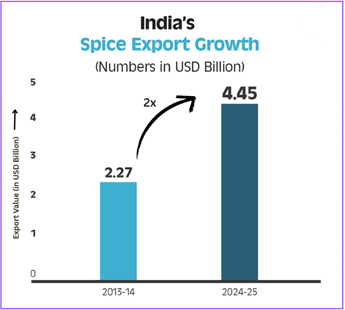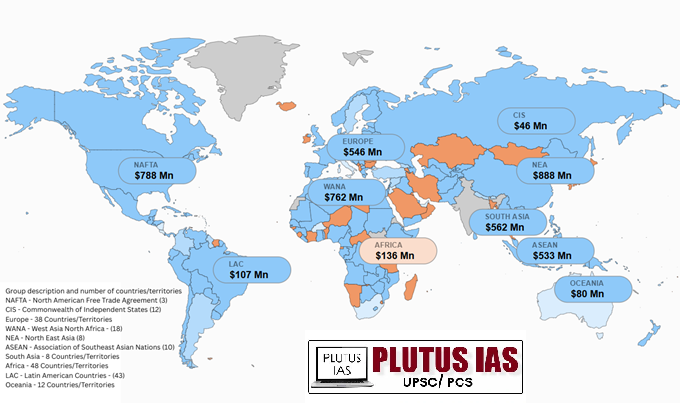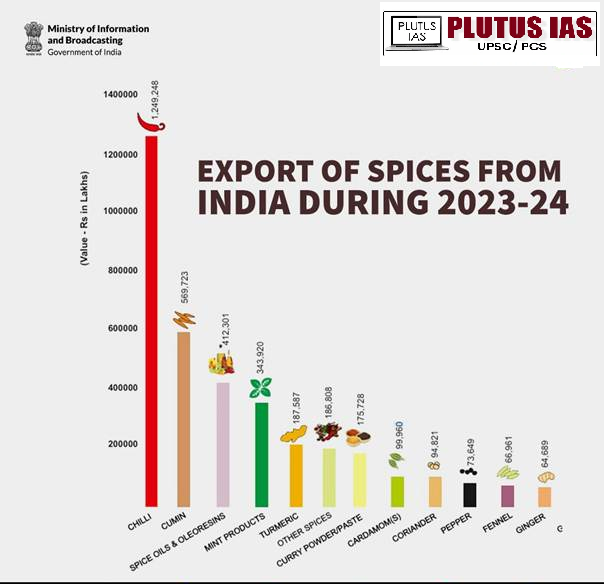07 May Trading Aromas: The Rise of the Spice Economy
This article covers “Daily Current Affairs” and the Topic Trading Aromas: The Rise of the Spice Economy.
SYLLABUS MAPPING:
GS-3- Economy- Trading Aromas: The Rise of the Spice Economy
FOR PRELIMS
What makes India the ‘Land of Spices’? What are the key objectives of the SPICED scheme? How does it aim to boost India’s spice exports?
FOR MAINS
What steps has the Indian government taken to support the spice industry?
Why in the News?
India, known as the ‘Land of Spices’, is the world’s largest producer, consumer, and exporter of spices. Of the 109 spices recognised by the International Organisation for Standardisation (ISO), India cultivates over 60 varieties. The spice sector contributes approximately 9% to India’s total agricultural exports and over 40% of horticultural exports. With a global footprint spanning over 200 countries, India exports 225+ unique spice products, reinforcing its position as a trusted global supplier of both raw and value-added spices. Historically valued for their medicinal properties, spices remain integral to both Indian heritage and global health-conscious markets.
India spices Economy
India is the largest exporter of spices and spice items. It retained its position as the leading global exporter, with exports reaching USD 4.45 billion in FY 2024–25. Between 2013–14 and 2024–25, spice exports increased by 88% in volume, and 97% in value (USD)—reflecting India’s expanding presence in the global spice market. Gujarat led with 23.53% of total exports, followed by Kerala and Andhra Pradesh. In comparison, during 2013–14, spice exports stood at 817,250 MT, valued at USD 2,267.67 million, showcasing a significant growth trajectory over the years.

Status of the species economy in India
Major Export Destinations
By December 2024, India had exported spices and spice products to 200 countries across the globe. The top 10 importers—namely China, the United States, the UAE, Bangladesh, Thailand, Malaysia, the UK, Saudi Arabia, Indonesia, and Germany—together contributed to over 60% of India’s total spice export revenue for FY25 (up to February 2025). Among these, the USA imported a wide range of Indian spices, including celery, cumin, curry powder, fennel, fenugreek, garlic, chilli, and mint-based products.

Region-wise total export from India
India’s Most Exported Spices by Value
In the financial year 2023–24, chilli stood out as India’s most exported spice, generating export earnings of USD 1,508.94 million. Cumin followed with USD 700.23 million, while spice oils and oleoresins contributed USD 498.01 million. Additionally, mint products, turmeric, and curry powders or pastes were among the key contributors to India’s overall spice export performance.

Top Spice-Producing States in India
In the 2023–24 period, Madhya Pradesh emerged as the top spice-producing state in India, contributing 3.63 million tonnes. It was followed by Gujarat and Andhra Pradesh, which produced 1.29 million and 1.28 million tonnes, respectively. Rajasthan and Telangana also registered notable outputs, exceeding 1 million tonnes and 793,000 tonnes. Collectively, these five states form the backbone of India’s dominant position in the global spice industry.

Government Initiatives to promote the species economy
1. Export Development and Promotion of Spices: Launched by the Spices Board of India with a ₹422.30 crore outlay under the 15th Finance Commission (till FY 2025–26), the SPICED scheme aims to boost spice exports, improve cardamom productivity, and enhance post-harvest quality. It supports FPOs, SMEs, and SC/ST groups, promotes value addition, GI-tagged spices, and runs initiatives like Mission Value Addition and Mission Clean and Safe Spices to strengthen India’s spice sector.
2. Setting up and Maintenance of Common Processing Infrastructure (Spices Parks): To strengthen processing and value addition in spices, the Spices Board has developed eight crop-specific Spices Parks across various states in India. These parks offer shared facilities for cleaning, sorting, grading, grinding, oil extraction, and packaging, catering to the needs of local farmers, exporters, traders, and other stakeholders.
| Spices Park | State | Spices Covered |
|---|---|---|
| Chhindwara | Madhya Pradesh | Garlic and Chilli |
| Guna | Madhya Pradesh | Coriander |
| Guntur | Andhra Pradesh | Chillies |
| Jodhpur | Rajasthan | Cumin |
| Ramganjmandi | Rajasthan | Coriander |
| Puttady | Kerala | Cardamom and Pepper |
| Raebareli | Uttar Pradesh | Mint |
| Sivaganga | Tamil Nadu | Chillies and Turmeric |
These parks also allocate plots to exporters, traders, and FPOs for establishing their own processing facilities. Their development aims to generate employment, both directly and indirectly, while accelerating the growth of the spice sector and enhancing India’s export capacity.
Spice economy contributions to economic growth

Challenges in the spice economy Sector
1. Quality and Contamination Issues: Spices often face problems like pesticide residue, aflatoxins, and microbial contamination, affecting export quality and global competitiveness.
2. Post-Harvest Losses: Inadequate post-harvest infrastructure and improper handling lead to significant losses and reduced market value of spices.
3. Fragmented Supply Chain: The spice value chain remains unorganised, with limited farmer access to markets, grading, and value addition facilities.
4. Price Volatility: Spices are highly sensitive to climate, pests, and global demand, leading to unstable prices and income uncertainty for farmers.
5. Low Productivity: Traditional cultivation methods, limited access to quality planting material, and poor irrigation result in low yield per hectare in many regions.
6. Inadequate R&D and Innovation: Limited investment in research for developing climate-resilient and high-yielding spice varieties hinders long-term sector growth.
7. Export Barriers and Compliance: Exporters face challenges in meeting the stringent quality and phytosanitary standards imposed by importing countries, especially in the EU and the US.
8. Climate Change Impact: Unpredictable weather patterns, rising temperatures, and irregular rainfall adversely affect spice crop productivity and quality.
Way forward
1. Enhance Quality Control: Strengthen testing labs, enforce quality standards, and promote organic and residue-free spice farming under initiatives like “Mission Clean and Safe Spices.”
2. Improve Post-Harvest Infrastructure: Invest in modern drying, grading, storage, and packaging facilities to reduce post-harvest losses and maintain export quality.
3. Strengthen Farmer Collectives: Encourage the formation of Farmer Producer Organisations (FPOs) to improve bargaining power, market access, and adoption of value-added practices.
4. Ensure Price Stability: Develop price forecasting systems, provide crop insurance, and explore Minimum Support Price (MSP) models for key spices to reduce farmer vulnerability.
5. Increase Productivity: Supply quality seeds and planting materials, promote Good Agricultural Practices (GAP), and expand farmer training and extension services.
6. Boost Research and Innovation: Support spice-specific R&D through public-private partnerships, and foster innovation via Spice Incubation Centres under the SPICED scheme.
7. Facilitate Export Compliance: Train exporters and farmers on international standards (such as EU and US norms) and improve access to certification and testing services.
8. Address Climate Risks: Promote climate-resilient spice varieties, adopt water-efficient methods like drip irrigation, and encourage crop diversification to adapt to weather variations
Conclusion
India’s spice economy stands as a pillar of the nation’s agricultural and export sectors, deeply rooted in its cultural heritage and global trade legacy. With rising global demand for natural, organic, and health-enhancing products, Indian spices hold immense potential to drive inclusive rural growth, employment, and foreign exchange earnings. Government initiatives like the SPICED scheme and Spices Parks, coupled with technological upgrades and quality enhancement, are strengthening the sector’s foundation. Going forward, a focus on innovation, sustainability, and global market integration will be key to securing India’s leadership in the global spice economy.
Download Plutus IAS Current Affairs (Eng) 07th May 2025
Prelims Questions
Q. With reference to India’s spice economy, consider the following statements:
1. India cultivates more than half of the spices recognised by the International Organisation for Standardisation (ISO).
2. Chilli was the top spice exported from India in terms of value in FY 2023–24.
3. The SPICED scheme is implemented by the Agricultural and Processed Food Products Export Development Authority (APEDA).
Which of the statements given above is/are correct?
(a) 1 and 2 only
(b) 2 and 3 only
(c) 1 and 3 only
(d) 1, 2 and 3
Answer: A
Mains Questions
Q. India’s spice economy is not only a reflection of its agricultural strength but also a gateway to global markets.” Discuss the significance of the spice sector in India’s economic development. Highlight recent initiatives taken by the government to enhance its export potential.
(250 words, 15 marks)




No Comments